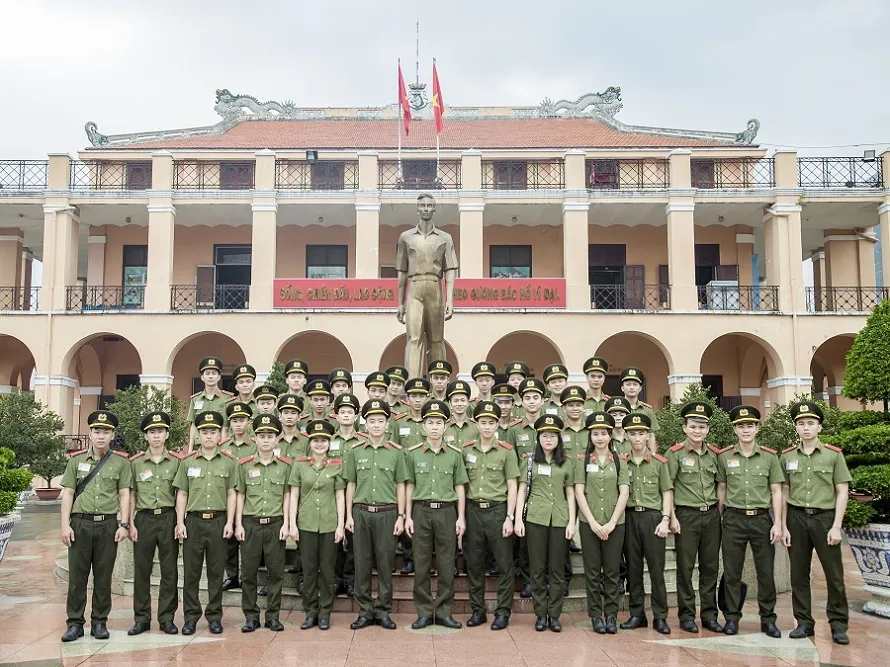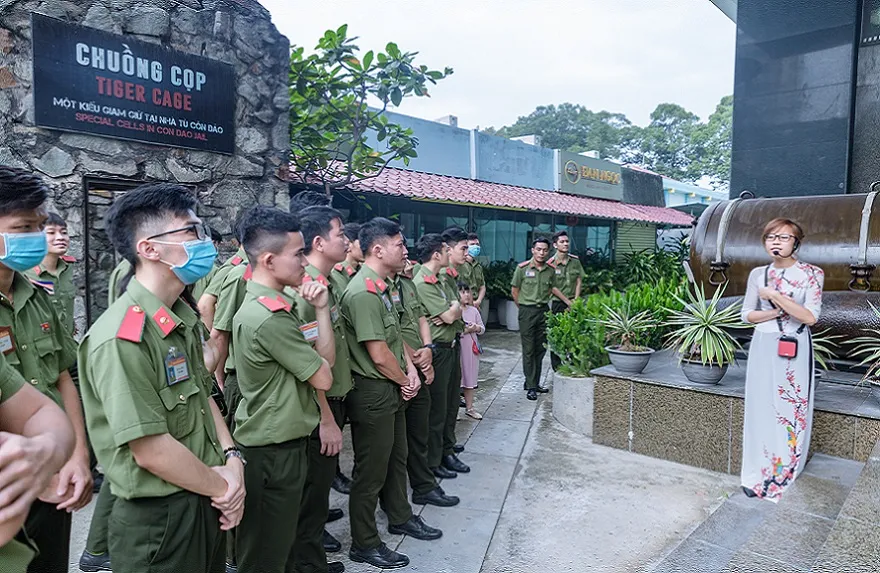Vietnam, a nation that has endured decades of war, is not only famed for its breathtaking natural beauty but also for preserving profound historical and heroic vestiges. These war memorials are more than just structures; they are living witnesses to history, recounting a period marked by immense suffering yet also extraordinary resilience of the Vietnamese people. Visiting these sites is a journey back in time, allowing present and future generations to deeply understand the value of peace, the sacrifices of their ancestors, and to cherish the present life. This article serves as a guide to exploring significant war memorials in Vietnam, helping you embark on a meaningful and emotionally resonant journey.
Nha Rong Wharf – The Starting Point of National Liberation
Nha Rong Wharf, nestled along the poetic Saigon River, is not only a national historical site but also a sacred symbol in the heart of every Vietnamese citizen. It was here, on June 5, 1911, that young Nguyen Tat Thanh embarked on the ship Amiral Latouche Tréville, beginning his 30-year journey across the world to find a path to national salvation.
Today, Nha Rong Wharf is part of the Ho Chi Minh Museum – Ho Chi Minh City branch. Here, you can admire the unique architecture imbued with late 19th-century French style, learn about the history of Nha Rong Wharf’s formation and development through various periods. In particular, the exhibition space dedicated to President Ho Chi Minh will help you better understand his life and great revolutionary career, from his youth, his journey to find a way to save the country, to leading the Vietnamese people to independence and freedom.
Visiting Tips for Nha Rong Wharf:
- Address: No. 01 Nguyen Tat Thanh Street, Ward 12, District 4, Ho Chi Minh City.
- Opening Hours:
- Morning: 7:30 AM – 11:30 AM
- Afternoon: 1:30 PM – 5:00 PM
- Open all days of the week, including holidays and Tet.
- Entrance Fee: Free.
- Transportation: Nha Rong Wharf is located in the city center, easily accessible by motorbike, car, or bus. You can take buses number 02, 03, 04, 19, 20, 46, 53, 56, 93, 102, 152.
- Note: When visiting, maintain order, general hygiene, and respect the solemn space of the historical site.

War Remnants Museum – A Powerful Indictment of War Crimes
The War Remnants Museum, located in the heart of District 3, Ho Chi Minh City, is an unmissable destination for those seeking to understand the Vietnam War. The museum displays authentic and vivid artifacts, images, and documents about the crimes and severe consequences of the invading wars that Vietnam endured.
Visiting the War Remnants Museum, you will be deeply moved to witness firsthand the massive “war machines” such as airplanes, tanks, artillery, bombs, and mines… along with poignant images and stories of Agent Orange victims, orphaned children, and displaced families. Each artifact, each photograph is a powerful indictment of the brutality of war and the burning desire for peace of the Vietnamese people.
Visiting Tips for the War Remnants Museum:
- Address: No. 28 Vo Van Tan Street, Ward 6, District 3, Ho Chi Minh City.
- Opening Hours: 7:30 AM – 6:00 PM daily, including holidays and Tet.
- Entrance Fee:
- Adults: 40,000 VND/person
- Students: 20,000 VND/person
- Students (schoolchildren): 10,000 VND/person
- Free for children under 6 years old and individuals with meritorious services to the revolution.
- Transportation: The museum is centrally located, easily accessible by various means of transport. Bus is an economical option; you can take routes number 05, 06, 14, 26, 28, 69, 93.
- Note: Allocate at least 2-3 hours to fully explore the museum. Prepare yourself emotionally for the disturbing images and stories of war.

Cu Chi Tunnels – Symbol of People’s War
The Cu Chi Tunnels, located about 70km from the center of Ho Chi Minh City, are a unique and intricate underground tunnel system. Constructed from the 1940s, the Cu Chi Tunnels became a solid base for our soldiers and people during the resistance war against the Americans for national salvation.
Visiting the Cu Chi Tunnels, you will explore an “underground city” with a complex network of tunnels, military structures, infirmaries, kitchens, and food and weapon storage. You will be amazed by the creativity, resilience, and brave fighting spirit of the Cu Chi soldiers and people. Additionally, you will have the opportunity to experience life underground, fire an AK-47 rifle, and watch documentary films about the war.
Visiting Tips for Cu Chi Tunnels:
- Address: Provincial Road 15, Phu Hiep, Cu Chi, Ho Chi Minh City.
- Opening Hours: 7:00 AM – 5:00 PM daily.
- Entrance Fee:
- Ben Dinh Area: 110,000 VND/person (Vietnamese visitors) – 155,000 VND/person (International visitors).
- Ben Duoc Area: 90,000 VND/person (Vietnamese visitors) – 135,000 VND/person (International visitors).
- Transportation:
- Bus: Take bus number 13 from Ben Thanh Bus Station to Cu Chi Bus Station, then take bus number 79 or 126 to Cu Chi Tunnels.
- Car, Motorbike: Follow National Highway 22 to An Suong intersection, turn left onto Truong Chinh Street (National Highway 22), continue straight to Cu Chi and follow the signs to the tunnels.
- Note: Wear sports shoes or low heels for easy movement in the tunnels. If you have a history of cardiovascular disease or difficulty breathing, consider carefully before going underground.
Con Dao Prison – “Hell on Earth” and Symbol of Patriotism
Con Dao, a beautiful island with blue sea, white sand, and golden sunshine, harbors a painful past. Con Dao Prison, built by the French colonialists and American imperialists, was once a place of detention and brutal torture for thousands of revolutionary soldiers and Vietnamese patriots.
Visiting Con Dao Prison, you will witness firsthand the “tiger cages,” “rice grinding cellar,” “Phu Hai camp,” “Phu Son camp”… place names filled with haunting memories of the prison regime’s cruelty and the steadfastness and indomitable spirit of the communists. This place is not only a historical site but also a “red address” for educating younger generations about patriotism and revolutionary traditions.
Visiting Tips for Con Dao Prison:
- Address: Nguyen Chi Thanh Street, Con Dao District, Ba Ria – Vung Tau Province.
- Opening Hours: 7:00 AM – 5:00 PM daily.
- Entrance Fee: 20,000 VND/person.
- Transportation:
- Airplane: Direct flights to Con Dao are available from Ho Chi Minh City or Can Tho.
- High-speed Ferry: High-speed ferries to Con Dao are available from Vung Tau (takes about 3-4 hours).
- Motorbike, Car: Cannot travel by motorbike or car from the mainland to Con Dao.
- Note: Con Dao is an archipelago; you need to book flight or ferry tickets in advance to ensure your trip. Bring sunscreen, hats, and drink enough water when visiting.
Quang Tri Citadel – Witness to the Red Summer of 1972
Quang Tri Citadel, located beside the Thach Han River, is a particularly important historical site in the resistance war against the Americans. It was the site of the fierce 81-day battle in the summer of 1972, one of the most intense battles of the Vietnam War.
Visiting Quang Tri Citadel, you will feel the tragic and heroic atmosphere of history. Although the citadel was heavily destroyed by bombs and bullets, the remaining traces are still enough to evoke memories of a difficult and arduous historical period. This place is a martyrs’ cemetery, a memorial to thousands of soldiers who bravely sacrificed themselves to protect the Fatherland.
Visiting Tips for Quang Tri Citadel:
- Address: Ward 2, Quang Tri Town, Quang Tri Province.
- Opening Hours: 7:00 AM – 5:00 PM daily.
- Entrance Fee: Free.
- Transportation:
- Airplane: Fly to Phu Bai Airport (Hue) or Dong Hoi Airport (Quang Binh), then take a bus or taxi to Quang Tri.
- Train: Arrive at Dong Ha Station (Quang Tri), then take a bus or taxi to Quang Tri Citadel.
- Bus, Car, Motorbike: Convenient to travel from neighboring provinces and cities to Quang Tri.
- Note: Quang Tri weather is quite harsh in the summer, so the best time to visit is autumn or spring. Bring hats, sunscreen, and drink enough water.
Conclusion
Vietnam offers not only stunning landscapes but also war memorials deeply imbued with historical significance. This guide to exploring war memorials in Vietnam is just a small glimpse into the countless meaningful historical sites across the country. Each memorial is a story, a lesson about history, patriotism, and the desire for peace. Take the time to visit these sites to better understand the heroic past of the nation, cherish the value of peaceful life today, and contribute to building a brighter future for the country.